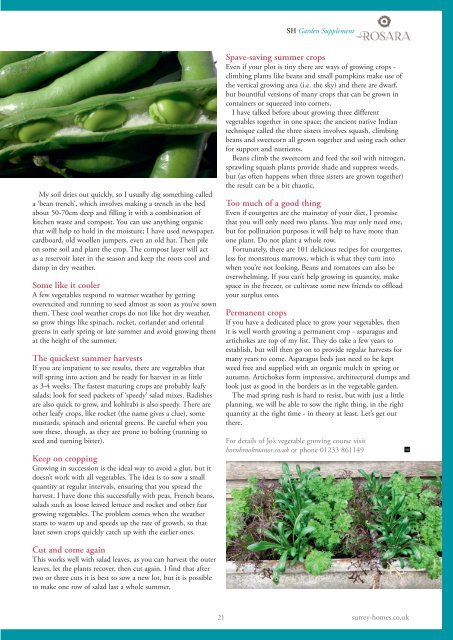Surrey Homes | SH42 | April 2018 | Garden supplement inside
The lifestyle magazine for Surrey - Inspirational Interiors, Fabulous Fashion, Delicious Dishes
The lifestyle magazine for Surrey - Inspirational Interiors, Fabulous Fashion, Delicious Dishes
Create successful ePaper yourself
Turn your PDF publications into a flip-book with our unique Google optimized e-Paper software.
SH <strong>Garden</strong> Supplement<br />
My soil dries out quickly, so I usually dig something called<br />
a ‘bean trench’, which involves making a trench in the bed<br />
about 50-70cm deep and filling it with a combination of<br />
kitchen waste and compost. You can use anything organic<br />
that will help to hold in the moisture; I have used newspaper,<br />
cardboard, old woollen jumpers, even an old hat. Then pile<br />
on some soil and plant the crop. The compost layer will act<br />
as a reservoir later in the season and keep the roots cool and<br />
damp in dry weather.<br />
Some like it cooler<br />
A few vegetables respond to warmer weather by getting<br />
overexcited and running to seed almost as soon as you’ve sown<br />
them. These cool weather crops do not like hot dry weather,<br />
so grow things like spinach, rocket, coriander and oriental<br />
greens in early spring or late summer and avoid growing them<br />
at the height of the summer.<br />
The quickest summer harvests<br />
If you are impatient to see results, there are vegetables that<br />
will spring into action and be ready for harvest in as little<br />
as 3-4 weeks. The fastest maturing crops are probably leafy<br />
salads; look for seed packets of ‘speedy’ salad mixes. Radishes<br />
are also quick to grow, and kohlrabi is also speedy. There are<br />
other leafy crops, like rocket (the name gives a clue), some<br />
mustards, spinach and oriental greens. Be careful when you<br />
sow these, though, as they are prone to bolting (running to<br />
seed and turning bitter).<br />
Keep on cropping<br />
Growing in succession is the ideal way to avoid a glut, but it<br />
doesn’t work with all vegetables. The idea is to sow a small<br />
quantity at regular intervals, ensuring that you spread the<br />
harvest. I have done this successfully with peas, French beans,<br />
salads such as loose leaved lettuce and rocket and other fast<br />
growing vegetables. The problem comes when the weather<br />
starts to warm up and speeds up the rate of growth, so that<br />
later sown crops quickly catch up with the earlier ones.<br />
Spave-saving summer crops<br />
Even if your plot is tiny there are ways of growing crops -<br />
climbing plants like beans and small pumpkins make use of<br />
the vertical growing area (i.e. the sky) and there are dwarf,<br />
but bountiful versions of many crops that can be grown in<br />
containers or squeezed into corners.<br />
I have talked before about growing three different<br />
vegetables together in one space; the ancient native Indian<br />
technique called the three sisters involves squash, climbing<br />
beans and sweetcorn all grown together and using each other<br />
for support and nutrients.<br />
Beans climb the sweetcorn and feed the soil with nitrogen,<br />
sprawling squash plants provide shade and suppress weeds,<br />
but (as often happens when three sisters are grown together)<br />
the result can be a bit chaotic.<br />
Too much of a good thing<br />
Even if courgettes are the mainstay of your diet, I promise<br />
that you will only need two plants. You may only need one,<br />
but for pollination purposes it will help to have more than<br />
one plant. Do not plant a whole row.<br />
Fortunately, there are 101 delicious recipes for courgettes,<br />
less for monstrous marrows, which is what they turn into<br />
when you’re not looking. Beans and tomatoes can also be<br />
overwhelming. If you can’t help growing in quantity, make<br />
space in the freezer, or cultivate some new friends to offload<br />
your surplus onto.<br />
Permanent crops<br />
If you have a dedicated place to grow your vegetables, then<br />
it is well worth growing a permanent crop - asparagus and<br />
artichokes are top of my list. They do take a few years to<br />
establish, but will then go on to provide regular harvests for<br />
many years to come. Asparagus beds just need to be kept<br />
weed free and supplied with an organic mulch in spring or<br />
autumn. Artichokes form impressive, architectural clumps and<br />
look just as good in the borders as in the vegetable garden.<br />
The mad spring rush is hard to resist, but with just a little<br />
planning, we will be able to sow the right thing, in the right<br />
quantity at the right time - in theory at least. Let’s get out<br />
there.<br />
For details of Jo’s vegetable growing course visit<br />
hornbrookmanor.co.uk or phone 01233 861149<br />
Cut and come again<br />
This works well with salad leaves, as you can harvest the outer<br />
leaves, let the plants recover, then cut again. I find that after<br />
two or three cuts it is best to sow a new lot, but it is possible<br />
to make one row of salad last a whole summer.<br />
21 surrey-homes.co.uk


















